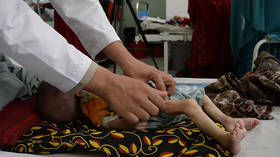600,000 Afghan children at risk of dying from malnutrition as international aid dries up

Hundreds of thousands of children in war-torn Afghanistan are in danger of dying from malnutrition, with officials warning that the health crisis is growing day by day. UNICEF says it lacks funds to properly address the issue.
Acute malnourishment affects an estimated two million children in Afghanistan. Of those, 600,000 are at risk of dying from severe acute malnutrition, the UN Children’s Fund has reported.
Doctors working to combat malnutrition in Afghanistan said that poverty, ongoing war, unsafe drinking water and poor education for mothers and families have exacerbated the problem.
Also on rt.com Taliban insurgents want peace, senior leader says at Moscow talks“The malnutrition level is spiking day by day in Afghanistan,” Muqeem Shah Miakhil, Head of Malnutrition Department of the Nangarhar Regional Hospital, told Ruptly. More than 15,000 women and children in Nangarhar have sought treatment for severe malnutrition so far this year, but less than half have recovered.
While the crisis isn’t new, malnutrition has become worse in Afghanistan due to a series of devastating droughts, Alison Parker, UNICEF’s Chief of Communication, Advocacy & Civic Engagement in Afghanistan, told RT.
“Nutrition is not just an issue of food,” Parker noted, listing safe water, sanitation and especially poverty as driving factors behind the crisis.
“The government recognizes that it needs a cohesive response,” Parker noted. However, funds to combat the malnutrition epidemic are drying up. UNICEF says that it needs an additional $7 million to provide aid to the growing number of malnourished children.
“Everyone is recognizing that it is a crisis,” Parker said, adding that she was hopeful that donors with big pockets would be able to help bridge the budget shortfall.
Last year, UNICEF provided assistance to nearly half of the country's most undernourished children. The organization is aiming to reach 60 percent, or 375,000, of those children this year.
Like this story? Share it with a friend!














